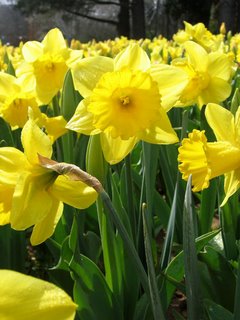
Monday, November 27, 2006
The Daily Hump: Daffodil
 The common daffodil, also known as a narcissus (which has an interesting etymology of its own), is a hardy bulb that flowers mainly in the spring. In Middle English the flower was known as affodil, coming from the Latin asphodelus, meaning "asphodel", which is basically another name for daffodils and some other plants in the lily family.* The flower first made its appearance (as affodill) in the English language around 1420.
The common daffodil, also known as a narcissus (which has an interesting etymology of its own), is a hardy bulb that flowers mainly in the spring. In Middle English the flower was known as affodil, coming from the Latin asphodelus, meaning "asphodel", which is basically another name for daffodils and some other plants in the lily family.* The flower first made its appearance (as affodill) in the English language around 1420.The mystery is, of course, how we got from the Middle English affodil to the Modern English daffodil. Where did that d come from? The OED has a number of theories:
It has been variously suggested as due to childish or playful distortion, as in Ted for Edward, tante for aunt; to union of the article th' (cf. COTGR., Affrodille, Th'Affodill, and north. Eng. t'affadil); to final d of and, in (e.g.) ‘fennell an-d affodil’; to union of the Dutch or Flemish article, as de affodil = the affodil; and to Fr. prep. d' as in fleur d'aphrodille...*Asphodel is also the flower that blooms along the plains of Hades. It was a favorite food of the dead and it takes little imagination to imagine toga-wearing zombies grazing on the asphodel pastures of the Elysium fields:
down the dank(Odyssey 24.5-9, translation by Robert Fagles)
moldering paths and past the Ocean's streams they went
and past the White Rock and the Sun's Western Gates and past
the Land of Dreams, and soon they reached the fields of asphodel
where the dead, the burnt-out wraiths of mortals make their home
Labels: Dutch, Flemish, Latin, Middle English, The Daily Hump
:: posted by David, 7:50 AM